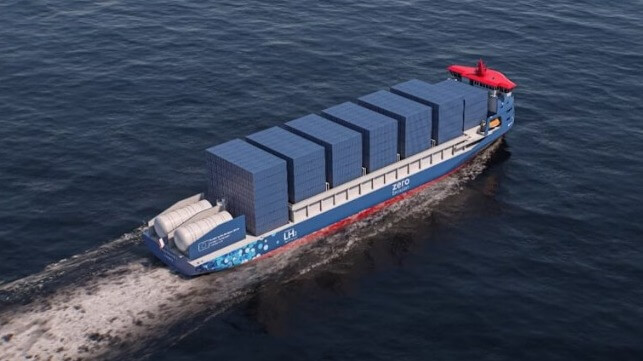Project to Build First Hydrogen-Power Containership Receives EU Funding

Energy Observer’s efforts to build the world’s largest liquid hydrogen-powered cargo ship are being advanced with the support of the European Union’s Innovation Fund. The containership concept known as EO2 was selected from 85 applications to the fund and awarded €40 million (US$42 million) to advance the development of the vessel.
The current design of EO2 is a 160-meter (525-foot) containership with a carrying capacity of 1,100 TEU. Energy Observer started the project in 2022 with the ambition to develop a demonstration ship that would be the world’s lowest carbon-emitting cargo ship. Energy Observer launched in 2017 with a laboratory vessel using a combination of solar, wind, and hydropower along with storage systems of batteries and hydrogen to be self-sufficient in energy, with zero emissions, zero fine particles, and zero noise. They conducted a global demonstration voyage and now are focusing their ambitions on the containership.
“EO2 represents an exceptional challenge, turning laboratory research into reality,” said Didier Boix, Managing Director of EO Concept. “With an onboard power of 4.8 MW, it’s equivalent to managing a fleet of one hundred hydrogen-powered vehicles, which means we need to step up our skills and rigorous management. We’re working at 360 degrees to integrate the ship’s technologies, structure a port ecosystem dedicated to liquid hydrogen, and develop a digital twin, not forgetting team training.”
To complete the project, the initial investment is estimated at over €100 million. That will cover studies and construction of the vessel. The group submitted its application to the EU in April 2024 as part of the solicitation that sought to encourage the development of clean technologies in sectors that are difficult to decarbonize.
The initial concept for EO2 calls for a vessel with a range of 14 days and 1,600 nautical miles. They plan to equip the vessel with an electric propulsion system powered by hydrogen fuel cells with 12 modules each capable of 400 kW LH2 to provide an average speed target of 12.5 knots. Reserve power and boost capacity would provide the vessel with a maximum speed of 16 knots. The fuel cells are being developed by EODev and its industrial partner Toyota.
It will be approximately 12,000 dwt and operate with a crew of 18. They project the vessel could reduce CO2 emissions by 112,250 tons over 10 years. The current plan projects commercial operations beginning in 2029 on Europe’s Atlantic and Channel coasts.
Accor a French hospitality company provided initial seed funding. Others including CMA CGM, Air Liquid, Toyota, EODev, LMG Marin, Bureau Veritas, Dassault Systems, and recently Chart Industries, have participated over the past two years in the feasibility studies. The project explored the optimum techno-economic model. Energy Observer reports the project selected the technical and logistical solutions required for the pilot project.
The aim is to demonstrate the technical and economic viability of liquid hydrogen for maritime transport on short segments. They also hope to contribute to consolidating Europe’s position as a leader in the energy transition to clean technologies.
No comments:
Post a Comment